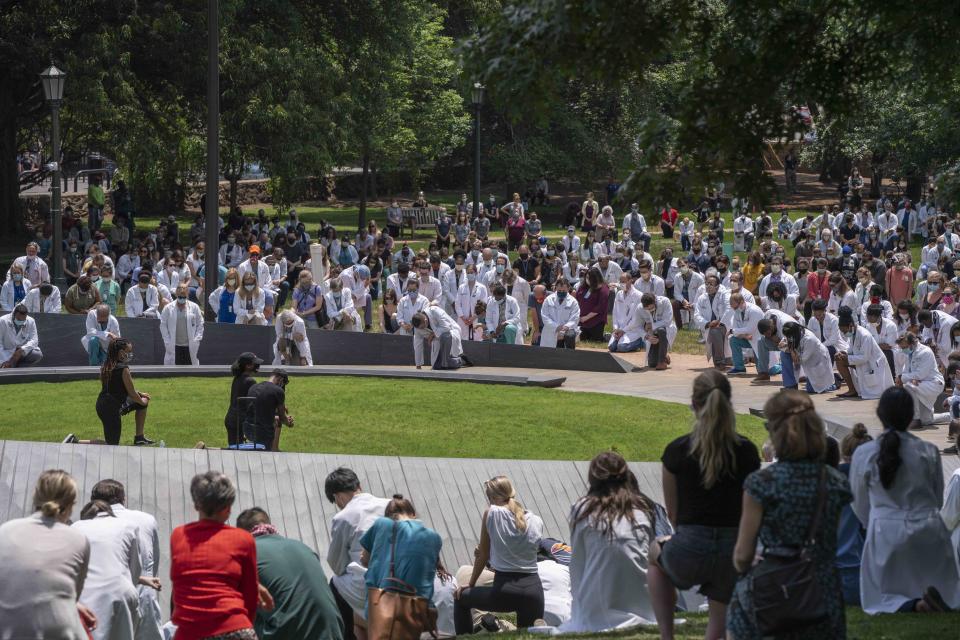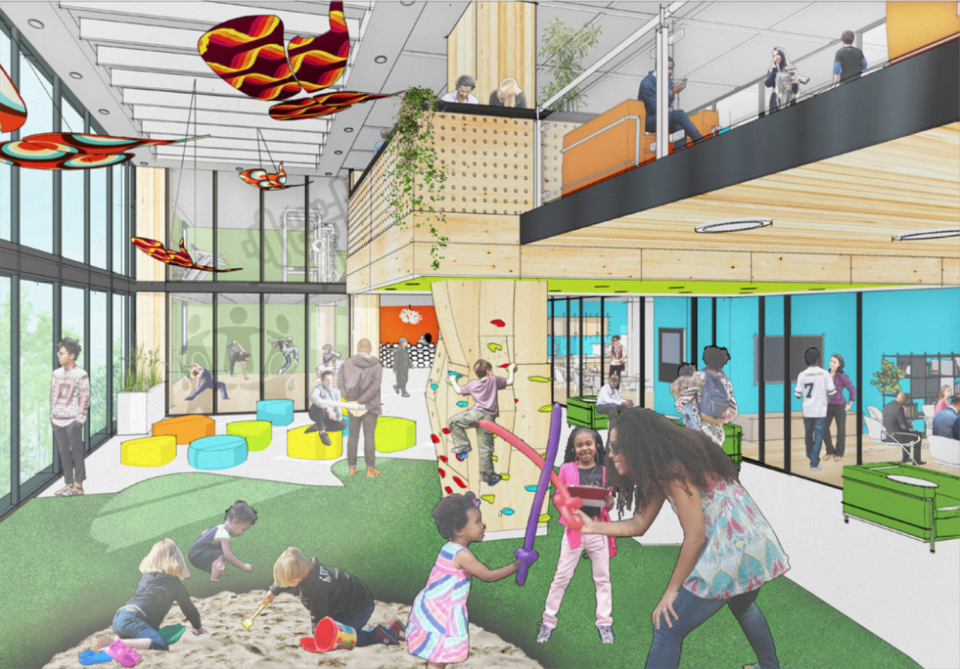Why Justice in Design Is Critical to Repairing America
In 2016, when Michelle Obama addressed the nation during a live broadcast from the Democratic National Convention, she said, “I wake up every morning in a house that was built by slaves.” Some listeners applauded her bold remarks, others were shocked; still others held out in their disbelief. There’s no question, however, that one of the very emblems of our nation, the White House—the seat of the highest office in the land, and arguably the world—was built using enslaved labor. Even if most history books don’t address it.
In so many ways, the built environment expresses who we are culturally and signals who holds power—those who have the money to make decisions can transform their ideas into their material surroundings. Since before the United States of America was even a nation, it was being constructed around a European worldview that was built on a hierarchy of racial inequity, explains Mabel O. Wilson, a professor at Columbia University’s Graduate School of Architecture, Planning and Preservation. As it grew, the U.S. constructed an image of its history through a particular lens, while disregarding its conquest of Indigenous people and its use of enslaved labor.
Building that identity of whiteness, says Wilson, “gives meaning to the culture—and all of that had to be invented,” which has informed our society, our systems, and even our democracy. “It’s not just about a feeling; it’s what builds the modern world,” adds the architect and author, who recently co-edited Race and Modern Architecture, which traces the discipline back to the Enlightenment. Today, racism and inequity are quite literally built into our culture.
For some of us, recognizing that revered emblems of our country actually represent the exploitation of one race for the benefit of another is difficult to hear and hard to admit; this inequity will be even tougher to repair. Yet acknowledging past injustice is a crucial step in rethinking, reframing, and restoring justice. “What would it mean to have an open conversation about people who are willing to talk about it that way?” asks Wilson.
A complex network of discriminatory policy and planning.

Chicago social housing
From Colonial-era and post–Civil War land grabs to 20th-century legal loopholes, a complex and purposeful network of American policy and planning has wittingly increased inequity among Black and Indigenous people as well as other people of color. Following World War II, when the suburban housing market began to boom, Black people—even those with nearly adequate wealth—were subjected to unfair housing policies and discriminatory lending. Consigned to particular neighborhoods, they were largely unable to purchase property in the suburbs, and thereby denied access to the middle class at a time when it was blossoming. The result today is a disproportionate burden where it comes to poverty, unemployment, homelessness, public safety, public health crises, food insecurity, environmental injustice, and much more.
Such spatial inequalities continued into the 1970s, when urban “renewal” programs across the U.S. approved new highways that cruelly slashed cities into neighborhoods of haves and have-nots, their boundaries clearly defined by siting public housing developments at their edges. Segregation had been deemed unconstitutional, but in the built environment, its physical imprints remain unmistakable.
Innumerable other waypoints along this timeline highlight the inequities intricately woven into our systems and our spaces, which persist today. And untangling these complexities and coming to grips with the true nature of America’s history is going to be rough. But it is also necessary.
Unbuilding and reframing to move toward design justice.

Design professionals alone, of course, are not to blame. But as a group of people who generally view themselves as progressive problem solvers, they have some power—and responsibility—to help un-build inequity. No one yet knows exactly how to build a just city. But with throngs of people pouring into the streets in support of Black Lives Matter—that is, into the very spaces where black Americans like George Floyd, Eric Garner, Ahmaud Arbery, and too many others, are being unlawfully killed by police—right now is the time to have some hard conversations and to reframe how we build and unbuild communities and spaces. “Architecture is really good at being the vanguard,” says Wilson. “But without material changes in people’s lives, it’s just hot air.”
There can be no moving forward until we acknowledge and reckon with our past. And while there’s no single prescription for moving toward design justice, we must seek to end the systemic power structures that enable oppressive architecture as well as radically rethink how we build neighborhoods that liberate and celebrate our disenfranchised communities and protect and strengthen their culture, stories, and sacred places.
Removing overtly racist emblems and monuments from towns and cities across the country is a logical early step. “Racist commemoration of false histories should be eliminated,” says Bryan C. Lee Jr., design principal of firm Colloqate, which fought for three years to remove Confederate and racist monuments in New Orleans. “It’s a false narrative and a false history that was set in place to set fear in black people.” Preservationists, too, are only beginning to address black history; too much has already been brushed aside.
Monuments to African American history are also crucial. Spaces such as the Memorial to Enslaved Laborers, in Charlottesville, Virginia, designed by Höweler + Yoon Architecture in collaboration with Wilson, honor the lives of enslaved people who worked for and built the University of Virginia. The National Memorial for Peace and Justice, located on six acres of land in Montgomery, Alabama, is a sobering monument to the thousands of Americans who were lynched.
“There’s a need to hold and claim space,” says Lee. “We should have many, many more memorials. We don’t recognize the pain of Black and Brown people in this country.”
In our buildings and cities, design justice also means radically rethinking the design process. “We have to institutionalize community power into the process,” says Lee. That means including a diversity of community voices at every level, from planning and zoning decisions and roles to rethinking proposal requests and financing.

Lee also emphasizes that architects and designers need longer lead times so they can listen to and engage with a broad spectrum of stakeholders from the start of any project. Design, of course, does not operate in a vacuum, and reframing supporting structures—public spending, banking, planning—needs to shift too, says Lee. For example, he says, “investing in affordable communities, not just affordable housing,” gets closer to solving a root problem. “If we’re able to expand the scope to where we can work with communities on use, and not just function, we can make a dramatic change right there.”
“It’s like people keep on trying to fix the fence, but you can’t; it’s built from rotted wood,” says architect Deanna Van Buren, cofounder, executive director, and design director of Designing Justice + Designing Spaces, which focuses on justice-centered work and ending mass incarceration. Like Lee, DJ+DS is interested in a deep design approach that addresses root causes of issues related to poverty, unequal access to resources, and the criminal justice system.
Working with community partners in the city of Atlanta, DJ+DS is transforming what was formerly the Atlanta City Detention Center into the Center for Equity. The citywide, yearlong, collaborative process brought together a broad spectrum of stakeholders—including a Mayor’s Task Force, community organizers, neighbors, law enforcement officials, and, very important, people who had been jailed there—to discuss and plan how to transform the site into a campus for building social and economic equity in the Black community.
“This process is a prototype for unbuilding racism and ending mass incarceration, and is the first citywide process and reimagining of its kind,” Van Buren and her team wrote about the project. DJ+DS has also helped create restorative justice centers in Oakland, California, and Syracuse, New York.
Prisons are “the built environment’s knee on the necks” of marginalized Americans.

High security Federal Prison in Florida USA
If a world without prisons seems incomprehensible, consider this: The 13th Amendment, passed in 1865, banned slavery and involuntary servitude, “except as a punishment for crime whereof the party shall have been duly convicted.” The phrase was inarguably an excuse to re-enslave Black labor and marks the moment our country entered into its condemnable moral contract with a prison-industrial complex. Even as rates of imprisonment have fallen overall in the past decade, the U.S. still has the highest rate of incarceration globally. And while Black Americans make up 12% of our population, they comprise more than a third of our incarcerated citizens.
Since 2004, the nonprofit organization Architects/Designers/Planners for Social Responsibility has called for professionals to boycott the design of prisons; since 2013, it has petitioned the American Institute of Architects to declare it unethical for members to design execution chambers or solitary-confinement spaces. The American Institute of Architects has not done so. Now consider that 88% of licensed architects working in the U.S. are white; just 2% are Black or African American, according to the National Council of Architectural Registration Boards.
“Prisons and jails are the built environment’s knee on the necks” of marginalized Americans, writes Van Buren. "What we had before and have today is an architecture of oppression, built on the backs of slaves and the bodies of prisoners. Now we are in a moment of protest and listening. What we will need is an architecture of liberation.”
What’s next.
Architects, designers, and planners are uniquely trained to think in cross-disciplinary ways to solve problems, and have a massive role to play in healthy built environments that consider their duty to diversity and inclusion. Who gets hired, who becomes a partner, and who moves into the C-suite matters. So does reframing how we teach architecture and design and their histories. But to truly reckon with the racial inequity baked into our buildings, neighborhoods, towns, and cities, we will have to infiltrate deep-seeded, systemic racism.
We must collectively acknowledge past inequity, address our inherent biases, and admit to—and reverse—the steady racist policies and practices that have ensured a status quo of white privilege. Our built environments should not reflect the history and power of a few. They need to represent, reflect, and emphasize justice for all.
“We have to understand what the built environment has done, and what we can do,” says Van Buren. “It starts everywhere and it is starting everywhere—and it needs to happen now.”
Originally Appeared on Architectural Digest


